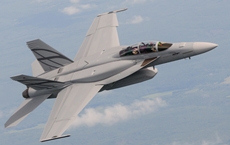Boeing prepared to make fighter jets in India
17 Oct 2015
Boeing chairman James McNerney said on Friday that his company will be happy to make its fighter jet F/A-18 Super Hornet in India if the Indian Air Force (IAF) were to buy it.
 McNerney, who met Prime Minister Narendra Modi on Thursday, believes this to be the best government he has seen in India in 35 years. Enthused, he wants Boeing, the defence and aerospace giant that earned $91 billion in revenues last year, to play a part in taking Indian manufacturing to global standards.
McNerney, who met Prime Minister Narendra Modi on Thursday, believes this to be the best government he has seen in India in 35 years. Enthused, he wants Boeing, the defence and aerospace giant that earned $91 billion in revenues last year, to play a part in taking Indian manufacturing to global standards.
The IAF has a depleted fleet and is looking for a twin-engine fighter aircraft as well as a single-engine one. The F/A-18 is a twin-engine supersonic multi-role and all-weather fighter.
''It is obvious to me there is active interest in more fighters ... however it shapes up, Boeing will have a fighter that can meet the requirement. What is different is our commitment to indigenise the manufacture of this fighter,'' McNerney, on a visit to the country, said in an interview with the Hindustan Times.
Boeing's proposal, he said, would involve both a state-of-the-art fighter as well as transfer of a significant amount of the production system to India, which will have a broad-based effect, not just in defence but also in other industries.
Asked if Boeing was inclined to make the F/A-18 in India, McNerney said, ''I think whichever system we offer, Make in India will be an important part of it. If F/A-18 were our offer, a significant Make in India part of the proposal will be there.''
McNerney, basking in the orders just placed by India for two of its helicopter models, Chinook, which is used for heavy lifting, and Apache, an attack aircraft, said Boeing would increasingly use partnerships around the world to make and design in other countries. ''In India I see the single biggest opportunity to do that.'' (See: Boeing to assemble Chinook or Apapche in India).
He said he likes the change in the way the Indian government and bureaucracy respond. ''I think what makes Prime Minister Modi special is that he is both a visionary and has his feet firmly on the ground ... he understands how hard it is to do the little things as well as how important it is to do the big things.''
McNerney cited the dialogue on the offset obligation as a fine example of the change in the bureaucracy's approach.
''They have listened to people like us, and made some improvements. There is a dialogue. There never used to be dialogue, there used to be take-it-or-leave-it.''




















